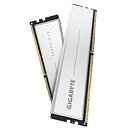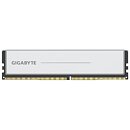Wednesday, February 5th 2020

GIGABYTE Rolls Out Designare DDR4-3200 High-Capacity 64GB (2x 32GB) Memory for Creators
The Designare brand of motherboards by GIGABYTE target content creators, and the company is extending the brand to memory, with the new Designare Memory series. It debuts with a high-capacity 64 GB dual-channel memory kit using two 32 GB modules. The rationale behind these densities is that creators may need them to deal with large data-sets. These are not off-spec "double height" modules, but are common dual-rank modules that stick to JEDEC compatibility spec, and pack XMP profiles that can run them at DDR4-3200 with 16-18-18-38 timings at 1.35 V.
GIGABYTE has tested these modules to work on all of its AMD X570, AMD B450, AMD TRX40, Intel X299, and Intel Z390 motherboards. For X570 and B450, however, the company states that only 3rd generation "Matisse" processors can handle this memory density. In its compatibility testing, GIGABYTE used 18-19-19-39 timings. Physically, the Designare modules have regular 32 mm height, a black PCB, and aluminium heatspreaders. GIGABYTE is backing the modules with lifetime warranty. The company didn't reveal pricing.
GIGABYTE has tested these modules to work on all of its AMD X570, AMD B450, AMD TRX40, Intel X299, and Intel Z390 motherboards. For X570 and B450, however, the company states that only 3rd generation "Matisse" processors can handle this memory density. In its compatibility testing, GIGABYTE used 18-19-19-39 timings. Physically, the Designare modules have regular 32 mm height, a black PCB, and aluminium heatspreaders. GIGABYTE is backing the modules with lifetime warranty. The company didn't reveal pricing.





24 Comments on GIGABYTE Rolls Out Designare DDR4-3200 High-Capacity 64GB (2x 32GB) Memory for Creators
If you can tell the difference between XXXX MHz and CL16 vs CL18 when not looking at a benchmark, color me impressed. :)
Just to set things straight.
www.techpowerup.com/review/amd-zen-2-memory-performance-scaling-benchmark/2.html
Memory frequency has a large effect on memory latency and bandwidth. In Ryzen's case also CPU speed (due to faster inter-core communication). Timings have much lower impact on latency, usually in the tune of couple or few milliseconds which has still minor but more noticeable effect when latency is lower to begin with.
32GB DIMMS are rare on the UE market right now. In the UK and France, many of the major retailers stock none, or only the ridiculously high-end, high-frequency gaming kits at 3x the cost/GB of standard speed (2400 or 2666) dual-rank RAM. I usually end up buying them for 128GB builds direct from Crucial who will offer sensible pricing for what is just pedestrian 2400 CL14 JEDEC-spec RAM; Creators want stability, not overclocking prowess.
As for the argument here over latencies, all that matters for Ryzen is absolute latency, which is CAS Latency/Frequency.
CL16/3200 = 5.0ns
CL14/2400 = 5.8ns
3600MHz is the fastest that the infinity fabric on Zen2 will run, so there's no point in going beyond that unless you can get MUCH faster, like 4133MHz or higher - where the extra bandwidth starts to become enough of an advantage to undo the damage of slower infinity fabric.
CAS Latency/Frequency is the latency of memory module itself (with some simplification), what matters for CPU is latency of memory at the core, this includes added latency from memory controller and whatever method of getting data to the core (IF and ringbus for Zen and Skylake respectively).
What matters for Ryzen specifically is not latency - it is the memory frequency due to the resulting IF frequency.
There are plenty of articles out there showing the results of this and why you want to, generally, stick to 1:1 whenever you are not going for frequency records.
AMD has that Memory Divider for the Uclk............ aka, @ 1800Mhz x2 ( 3600Mhz) ddr4. uclk @ 1:1 (same as Mclk (1800Mhz ) or 2:1 ( 1/2 Mclk aka 900Mhz uclk) so if u run 1/2 divider, the uclk is only 900Mhz!!! but.... over 3800mhz!
@ 3800 (1900 Mhz) DDR4 you have..... (if at 1:1 - its 1900Mhz )(which most of the time, is MAX) or (2:1 or 1/2 Divider, is 950Mhz... Fclk @ 1900 (or 950 Mhz) (Infinify Fabic Clock)...
so if you ran a 4000 Mhz ram kit...
@4000 Mhz (2000Mhz x2 ) ( 4000 Mhz) ddr4. uclk @ 1:1 (same as Mclk (2000 Mhz *(will not post ) or 2:1 ( 1/2 Mclk aka 1000 Mhz uclk) so if u run 1/2 divider, the uclk is only 1000 Mhz!!! but.... over 4000mhz!
1800MHz is the highest automatic fabric clock before dividers kick in for a 1:2 ratio between the IMC and the RAM itself, confirmed post-launch by official AMD rep in the official AMD reddit in answer to this question.
Amd/comments/cc1hta
You can, of course, overclock. I would expect that most samples, especially the 3600X, 3800X and higher to reach 3733 without any issues. The 65W variants (3700X, 3600) maybe not? Mine doesn't, that's for sure.
But good to see 32GB modules are getting more common,
Some day I will upgrade my 4×16GB RAM with 4×32GB :toast: